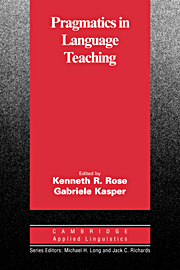Book contents
- Frontmatter
- Contents
- List of contributors
- Series editors' preface
- Preface
- Chapter 1 Pragmatics in language teaching
- I THEORETICAL AND EMPIRICAL BACKGROUND
- II ISSUES IN CLASSROOM-BASED LEARNING OF PRAGMATICS
- III THE EFFECTS OF INSTRUCTION IN PRAGMATICS
- IV THE ASSESSMENT OF PRAGMATIC ABILITY
- Chapter 12 Use of address terms on the German Speaking Test
- Chapter 13 Indicators for pragmatic instruction: Some quantitative tools
- Chapter 14 Pragmatics tests: Different purposes, different tests
- References
- Name index
- Subject index
Chapter 12 - Use of address terms on the German Speaking Test
Published online by Cambridge University Press: 05 October 2012
- Frontmatter
- Contents
- List of contributors
- Series editors' preface
- Preface
- Chapter 1 Pragmatics in language teaching
- I THEORETICAL AND EMPIRICAL BACKGROUND
- II ISSUES IN CLASSROOM-BASED LEARNING OF PRAGMATICS
- III THE EFFECTS OF INSTRUCTION IN PRAGMATICS
- IV THE ASSESSMENT OF PRAGMATIC ABILITY
- Chapter 12 Use of address terms on the German Speaking Test
- Chapter 13 Indicators for pragmatic instruction: Some quantitative tools
- Chapter 14 Pragmatics tests: Different purposes, different tests
- References
- Name index
- Subject index
Summary
Introduction
The measurement of sociolinguistic competence has proved problematic since Hymes's (1967, 1972) seminal discussions of Chomsky's (1965) distinction between competence and performance, especially given persistent uncertainties regarding how sociolinguistic knowledge interacts with other competencies (e.g., grammatical) and how these interactions are instantiated in learner L2 performance (McNamara, 1996). Nevertheless, that L2 learners need to acquire knowledge of sociocultural norms or rules of language behavior, as well as the ability to appropriately employ these rules in communication, is beyond dispute, as evidenced by their abiding presence in competence or ability models (e.g., Canale & Swain, 1980; Canale, 1983). Most recently, Bachman and Palmer (1996) located knowledge of sociocultural rules within their L2 “ability for use” framework:
Sociolinguistic knowledge enables us to create or interpret language that is appropriate to a particular language use setting. This includes knowledge of the conventions that determine the appropriate use of dialects or varieties, registers, natural or idiomatic expressions, cultural references, and figures of speech. When we use different registers … sociolinguistic knowledge is involved.
(p. 70)Given this fundamental role for sociolinguistic competence within notions of language competence and ability, it follows that language assessment which purports to measure such global constructs as L2 proficiency must necessarily include the measurement of learners' command of sociocultural rules and corresponding L2 forms.
- Type
- Chapter
- Information
- Pragmatics in Language Teaching , pp. 248 - 282Publisher: Cambridge University PressPrint publication year: 2001
- 7
- Cited by



